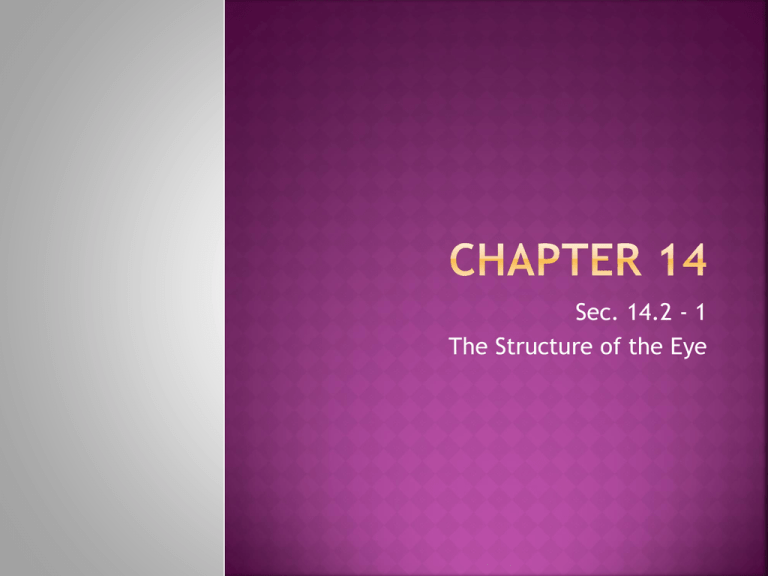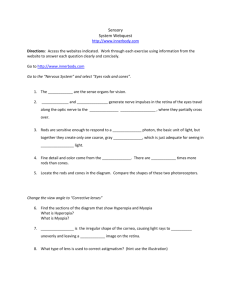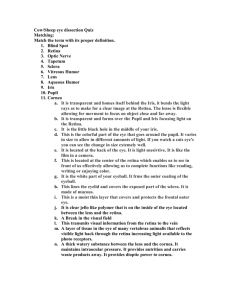14.2 part 1
advertisement

Sec. 14.2 - 1 The Structure of the Eye One of the primary ways humans gather information about their environment is through visual information supplied by the sensory receptors in the eye. Video: The Human Eye http://www.youtube.com/watch?v=JunCyiGfreo Our eye is made up of 3 layers: 1. Sclera 2. Choroid 3. Retina Layer Sclera - is the outer covering of the eye that supports and protects the eye’s inner layers; usually called the white of the eye. The front of the sclera is called the cornea. Cornea – transparent part of the sclera that protects the eye and bends light toward the pupil. The cornea is a tissue and like all tissues it requires oxygen and nutrients, but it cannot have blood vessels running through it or our vision would be clouded. Most of the oxygen is absorbed from the gases dissolved in tears. Nutrients humour. Aqueous are supplied by the aqueous humour – water liquid that protects the lens of the eye and supplies the cornea with nutrients. The choroid layer – is the middle layer of tissue in the eye that contains blood vessels that nourish the retina. The Iris front of the choroid is called the iris. – muscle tissue surrounding the pupil (opening in iris) that regulates the amount of light entering the eye. The lens is found directly behind the iris. The lens - focuses the image on the retina. Ciliary muscles - alter the shape of the lens so we can change our focus between close and distant objects. A large chamber behind the lens is called the vitreous humour. The vitreous humour - contains a cloudy, jelly-like material that maintains the shape of the eyeball and allows light to flow to the retina. The retina – is the innermost layer of tissue at the back of the eye containing photoreceptors. There are two types of photoreceptors: 1. Rods – allow us to see black and white images and in dim light. 2. Cones – allow us to see colour. We have about 18 times more rods than cones. The rods and cones receive the sensory information and pass it to a bipolar cell. The bipolar cell passes the information to a clump of nerves called a ganglion. The group of ganglions come together to form the optic nerve. The optic nerve then carries the impulse through the temporal lobe to the occipital lobe at the back of the brain. Rods and cones are unevenly distributed on the retina. In the center of the retina is a tiny depression called the fovea centralis. The fovea centralis – is an area at the center of the retina where cones are the most dense and vision is the sharpest. Rods surround the fovea centralis, which explains why you may see an object from your periphery in black and white. The junction where the optic nerve comes in contact with the retina does not contain any rods or cones. We cannot see out of this area and it is therefore referred to as the blind spot. Structure Function Sclera - Supports and protects eye Cornea - Bends (refracts) light toward pupil Aqueous humour - Supplies cornea with nutrients Choroid layer - Contains blood vessels that nourish the retina Iris - Regulates the amount of light entering the eye Vitreous humour - Maintains shape of eyeball and allow light into retina Lens - Focuses image on the retina Pupil - The opening in the iris that allow light in to eye Retina - Contains rods for b and w and cones for colour Fovea centralis - Cones are the most concentrated, clearest vision Blind spot - Where the optic nerve attaches to retina





